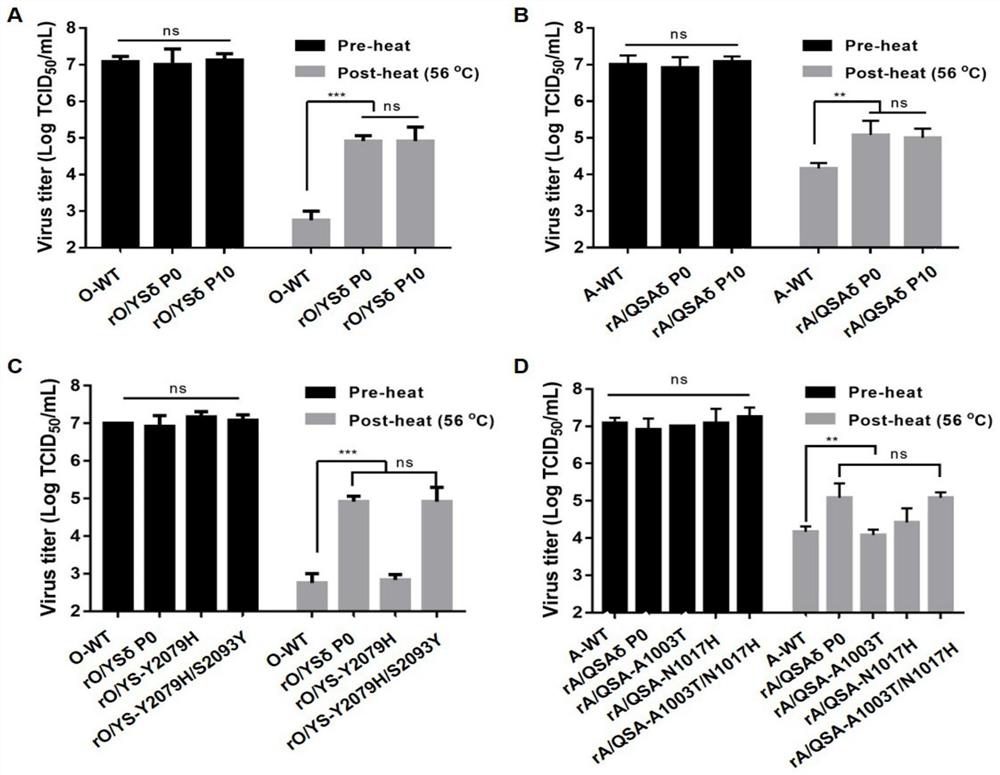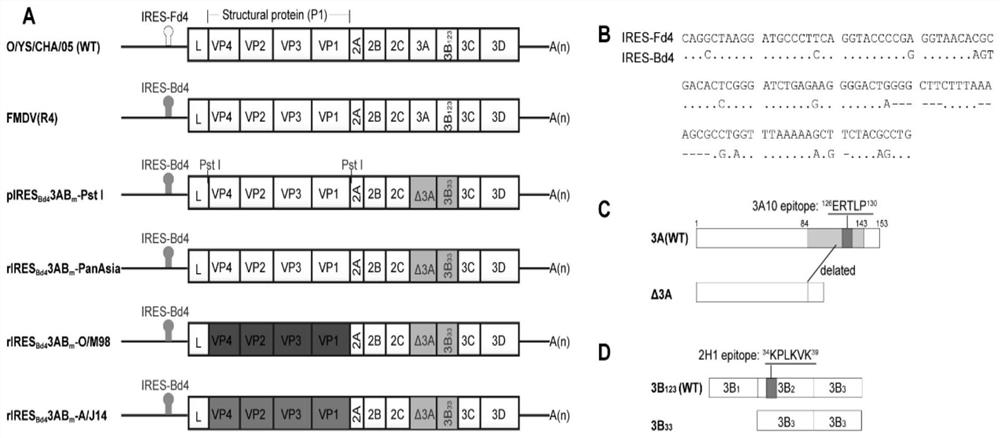Recombinant foot-and-mouth disease virus non-toxic strain with heat-resistant phenotypic stable inheritance and negative marker and O/A type foot-and-mouth disease bivalent inactivated vaccine
A foot-and-mouth disease virus, avirulent strain technology, applied in the direction of virus/phage, vaccine, virus, etc., can solve the problem of animal species limitation, failure to find, attenuation and other problems
- Summary
- Abstract
- Description
- Claims
- Application Information
AI Technical Summary
Problems solved by technology
Method used
Image
Examples
Embodiment 1
[0055] Embodiment 1 FMDV (R4) virus strain is to the evaluation of pig pathogenicity
[0056] Previous studies have found that the IRES chimeric virus FMDV (R4) generated by replacing FMDV IRES domain 4 (IRES-Fd4) with bovine rhinovirus (BRBV) IRES domain 4 (IRES-Bd4) has a 10 6 TCID 50 / The first dose of neck muscle inoculation of natural host pigs does not show any clinical symptoms of foot-and-mouth disease, does not produce viremia, oral and nasal cavity does not shed toxin, and the virus does not induce antibodies in pigs, indicating that the virus has lost replication in susceptible animals For details, please refer to the Chinese invention patent (CN108085302A) and the international PCT patent (application publication number: WO / 2018 / 090994). In order to further evaluate the pathogenicity of FMDV (R4) to pigs, the most sensitive heel intradermal inoculation route was used, and a higher FMDV (R4) inoculation dose (10 7 TCID 50 / head or 10 8 TCID 50 / head), and inoc...
Embodiment 2
[0060] Example 2 Comparison of molecular labeling methods on 3B protein
[0061] In order to construct a molecular marker virus that can be used for differential diagnosis, this experiment conducted a comparative study on the molecular marker methods on the 3B protein. The inventor's laboratory obtained a monoclonal antibody 2H1 against FMDV non-structural protein 3B2 in the previous research, and determined the antigenic epitope it recognizes. The epitope motif is 34 KPLKVK 39 , K 34 、K 37 and V 38 It is the key amino acid of this epitope (CN109295005A, invention patent application number: 201811126187.4). In order to inactivate the epitope recognized by the monoclonal antibody 2H1 and introduce the antigen molecular marker, the key amino acid K of the 2H1 epitope is replaced with alanine (A) at the same time 37 and V 38 , construct the eukaryotic expression plasmid pCI-3B1 of this 3B1 epitope inactivation m twenty three. In addition, the analysis of the antigenicity ...
Embodiment 3
[0062] Example 3 Screening of genetically stable FMDV heat-resistant mutants and determination of molecular determinants of heat-resistant phenotype
[0063] 1 Test method
[0064] 1.1 Thermal stress screening method for foot-and-mouth disease virus
[0065] The thermal pressure screening of the virus is to heat at a specific temperature for 30 minutes to inactivate 99.99% of the virus titer per unit volume, and to carry out repeated heat inactivation tests under the condition of gradually increasing the temperature until the temperature before and after heating Virus titers are approximately the same. Multiple rounds of heat selection were performed at temperatures of 51°C, 53°C, and 56°C until the emergence of highly heat-adapted virus mutants.
[0066] 1.2 Detection method of virus capsid stability
[0067] After the virus is treated at a higher temperature, the proportion of the 146S intact virus capsid is determined, which is a key indicator for judging the thermal sta...
PUM
| Property | Measurement | Unit |
|---|---|---|
| Titer | aaaaa | aaaaa |
Abstract
Description
Claims
Application Information
 Login to View More
Login to View More - R&D
- Intellectual Property
- Life Sciences
- Materials
- Tech Scout
- Unparalleled Data Quality
- Higher Quality Content
- 60% Fewer Hallucinations
Browse by: Latest US Patents, China's latest patents, Technical Efficacy Thesaurus, Application Domain, Technology Topic, Popular Technical Reports.
© 2025 PatSnap. All rights reserved.Legal|Privacy policy|Modern Slavery Act Transparency Statement|Sitemap|About US| Contact US: help@patsnap.com



